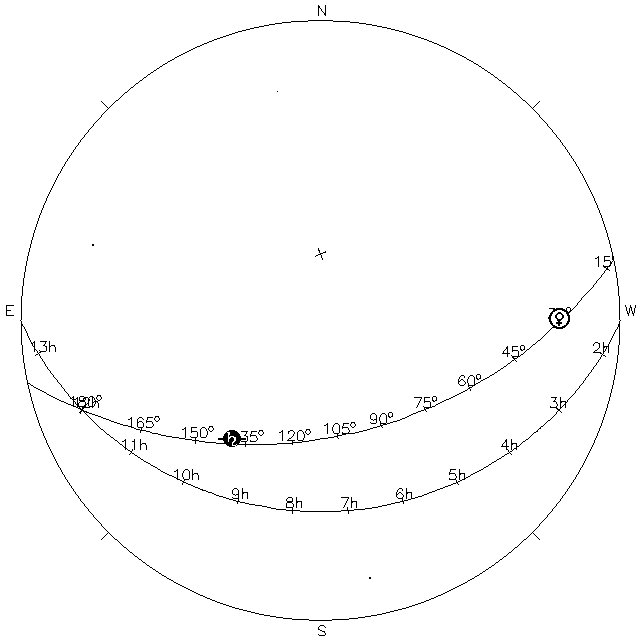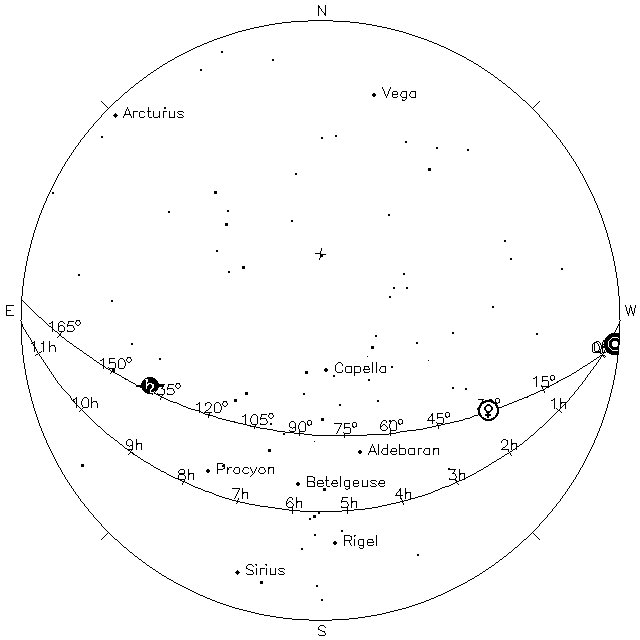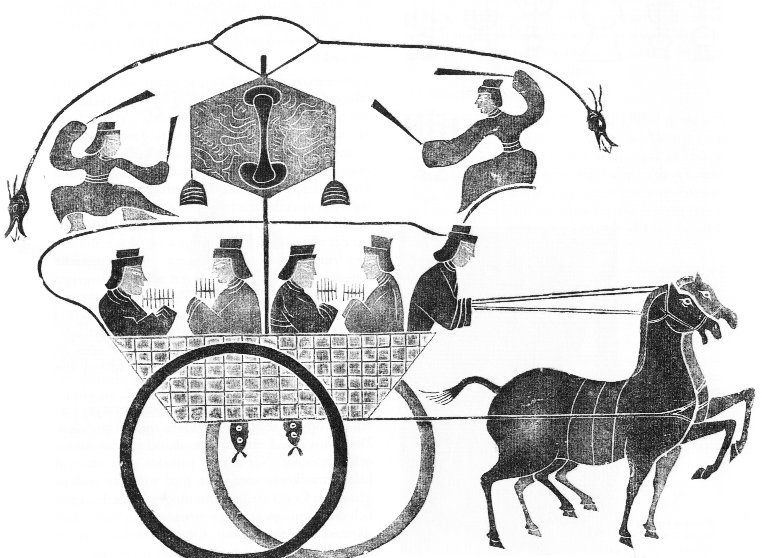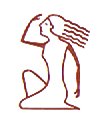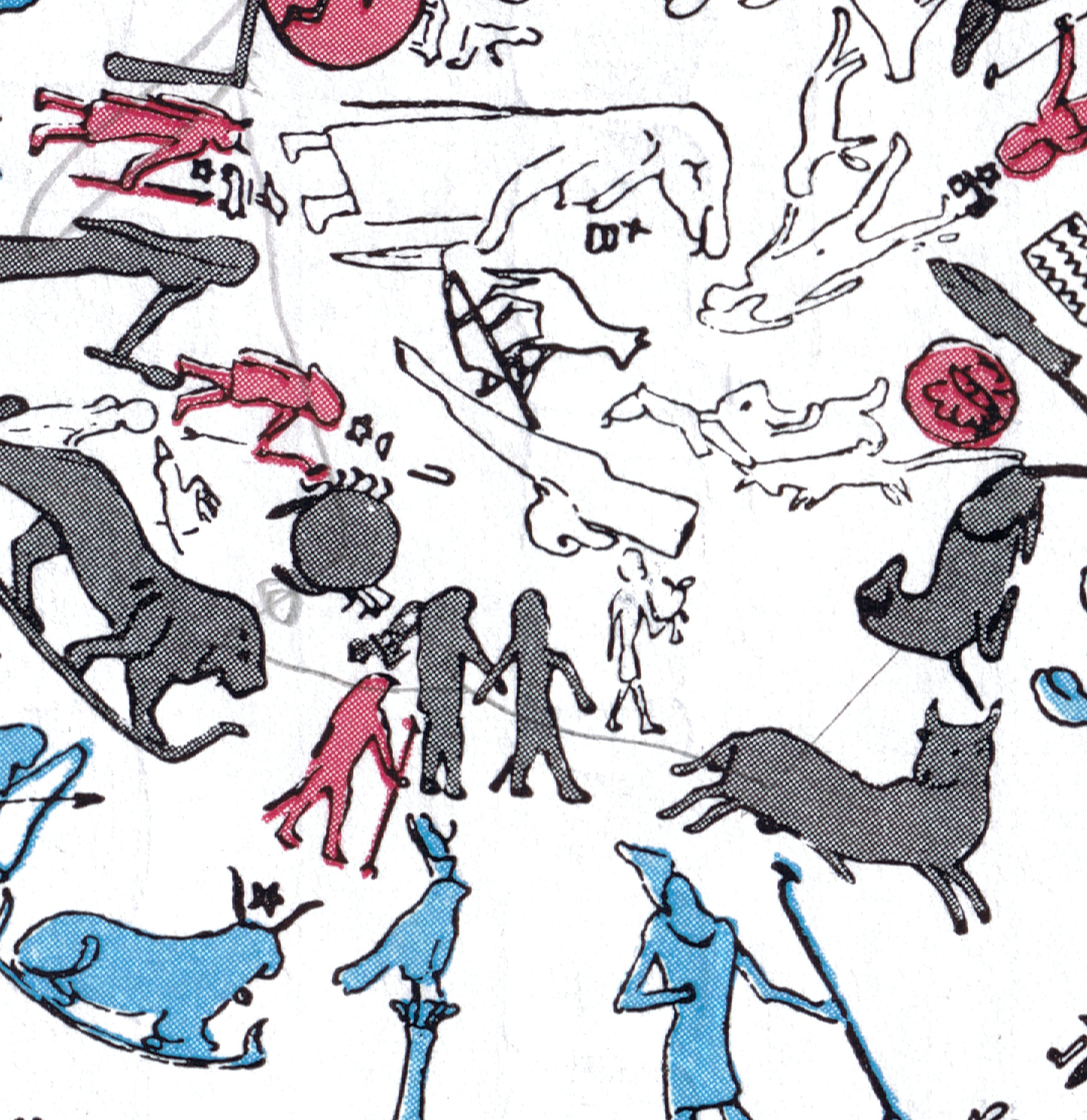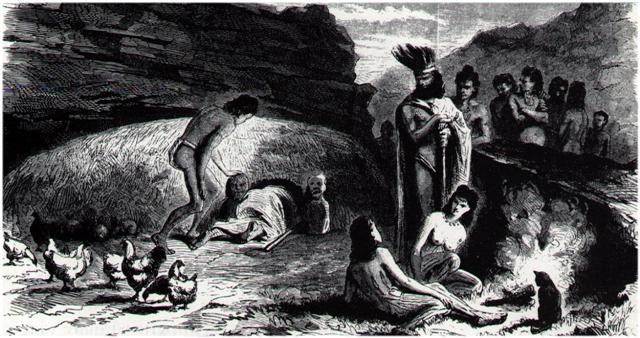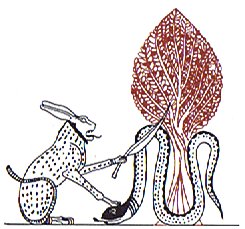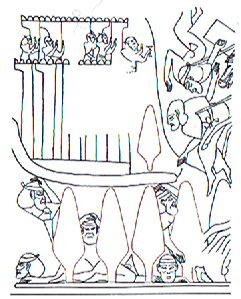|
TRANSLATIONS
The day before yesterday I happened to be out walking just after sundown. It was a very clear sky, but the sun still made the sky light blue and the stars were invisible. But suddenly I noticed two very bright objects and identified them as planets. For the first time in my life (as far as I can remember) I experienced the slightly bent curve along which they and the sun travel, the ecliptic. Already stone age man must certainly have connected the planets with the sun because they followed in his trail! Then I also realized why sunday should come first among the days of the week. A 'map' must depict the true reality. But what planets had I observed? Due to the intensity of their lights I guessed at Venus, Mars or Jupiter. Yesterday it was very cloudy and much snow was falling, which made even the sun invisible, and I couldn't continue with my observations. In the evening I therefore decided to find out with certainty which planets I had seen. There is an internet site, http://www.fourmilab.ch/cgi-bin/Yoursky, which is suitable for this purpose and after a while I succeeded in identifying the two planets, they were Saturn and Venus:
I was a bit surprised, because I had imagined that Saturn was rather pale and difficult to see: "Fetu-tea [Pale Star = Saturn] was the king. He took to wife the dome of the sky, Te-Tapoi-o-te-ra'i, and begat stars that shine (hitihiti) and obscure, the host of twinkling stars, fetu-amoamo, and the phosphorescent stars, te fetu-pura-noa ..." (Makemson) But Fetu-tea should mean the 'white star', not the 'pale star'. If not tea is teka - a beam of light (measuring out the time). Next time the sky is clear I will locate the star Amalthea (α Auriga, Capella - the little she-goat). I know where too seek her because she is not far away from Saturn and Venus as they stand at present:
Allen: "It [Auriga, the Charioteer] is a large constellation stretching northward across the Milky Way from its star γ, which also marks one of the Bull's horns, to the feet of Camelopardis, about 30║ in extent north and south and 40║ east and west; and is shown as a young man with whip in the right hand, but without a chariot, the Goat being supported against the left shoulder and the Kids on the wrist. This, with some variations, has been the drawing from the earliest days, when, as now, it was important, chiefly from the beauty of Capella and its attendant stars so prominent in the northwest in the spring twilight, and in the northeast in early autumn." I recall the Eskimo constellation Quturjuuk: "These are the stars underneath the Tukturjuk (Ursa Major) known as Quturjuuk. There are two sets of stars, four stars in total, and they are brighter than others. They are shaped like qutu (the collar bone) and it is from this appearance that their name is derived. As we would travel at night heading for home after a hunt, with my father, I tried to make a habit of observing the stars as we trekked along, this was so I would know how late at night it was ..." (Arctic Sky) The four stars in question are (from left to right in the star map above) Pollux and Castor (in Gemini), and Menkalinan and Capella (in Auriga). Allen: "The 1515 Almagest says, 'et nominatur latine antarii ... id est collarium', - this Collarium perhaps referring to the collar in the Charioteer's harness." Allen also tells about Capella as a time piece: "It is the most northern of all the 1st magnitude stars, rising in the latitude of New York City at sunset about the middle of October, and culminating at nine o'clock in the evening of the 19th of January. Thus it is visible at some hour of every clear night throughout the year." "The early Arabs called it Al Rākib, the Driver; for, lying far to the north, it was prominent in the evening sky before other stars became visible, and so apparently watching over them; and the synonymous Al Hādī of the Pleiades, as, on the parallel of Arabia, it rose with that cluster." "The ancient Peruvians, the Quichuas, whose language is still spoken by their descendants, appear to have devoted much attention to the stars; and JosÚ de Acosta, the Spanish Jesuit and naturalist of the 16th century, said that every bird and beast on earth had its namesake in the sky. He cited several of their stellar titles, identifying this star with Coca, singularly prominent with their shepherds, as Capella was with the same class of Mediterranean in ancient days ..." "The Chinese had an asterism here, formed by Capella with β, θ, κ, and γ, which they called Woo Chay, the Five Chariots - a singular resemblance in title to our Charioteer; although Edkins says that this should be the Chariots of the Five Emperors." To which I do not hesitate to offer my own opinion: that Woo Chay represents the five dark nights at new year time. Indeed we have a picture of them, with - presumably - one of them, 'Amalthea', driving:
Time is not abstract, it is the seasons of nature. Therefore we should take note of Allen's comment about the 'stormy' character of Capella: "This has been known as Capella, the Little She-goat, since at least the times of Manilius, Ovid, and Pliny, all of whom followed the Κινήσαι Χειμώνας of Aratos in terming it a Signum pluviale like its companions the Haedi, thus confirming its stormy character throughout classical days." Rising close to the time when the Pleiades are rising we can correlate the idea of the rainy Pleiades with the idea of the stormy Amalthea. And suddenly we understand that the hieroglyph iakbyt
may depict a woman in the midst of stormy weather. Allen has much to say about Capella and ancient Egypt: "Capella's place on the Dendera zodiac is occupied by a mummified cat in the outstretched hand of a male figure crowned with feathers; while, always an important star in the temple worship of the great Egyptian god Ptah, the Opener, it is supposed to have borne the name of that divinity and probably was observed at its setting 1700 BC from his temple, the noted edifice at Karnak near Thebes, the No Amon of the books of the prophets Jeremiah and Nahum. Another recent discovered sanctuary of Ptah at Memphis also was oriented to it about 5200 BC. Lockyer thinks that at last five temples were oriented to its setting." "For now it is essential to recognize that, whether one has to do with the Mesopotamian Saturn, Enki / Ea, or with Ptah of Egypt, he is the 'Lord of Measures' - spell it 'me' in Sumerian, 'parshu' in Akkadian, 'maat' in Egyptian. And the same goes for His Majesty, the Yellow Emperor of China - yellow, because the element earth belongs to Saturn - 'Huang-ti established everywhere the order for the sun, the moon and the stars'. The melody remains the same." (Hamlet's Mill) "The Akkadian Dil-gan I-ku, the Messenger of Light, or Dil-gan Babili, the Patron star of Babylon, is thought to have been Capella, known in Assyria an I-ku, the Leader, i.e. of the year; for, according to Sayce, in Akkadian times the commencement of the year was determined by the position of this star in relation to the moon at the vernal equinox. This was previous to 1730 BC, when, during the preceeding 2130 years, spring began when the sun entered the constellation Taurus; in this connection the star was known as the Star of Marduk, but subsequent to that date some of these titles were apparently applied to Hamal, Wega, and other whose positions as to that initial point had changed by reason of precession. One cuneiform inscription, supposed to refer to our Capella, is rendered by Jensen Askar, the Tempest God; and the Tablet of the Thirty Stars bears the synonymous Ma-a-tu ..." As spring equinox is close, just a few days ahead, I would like to know if on Easter Island this star is possible to observe too, and with the aid of Yoursky I arrived at this answer:
(Because of technichal difficulties the bottom part of the picture was impossible to obtain.) Clearly there is no problem to see Capella (Amalthea) from Easter Island. Latitude 27║ S gives the viewer access to most of the starry globe. The Egyptian hieroglyphs seem to be a fertile ground for digging into. The mummified cat on the zodiac of Dendera interests me. According to Wilkinson there is a hieroglyph showing a cat, appropriately called miu:
As to the mummified cat on the zodiac of Dendera I have not been able to verify its existence. It should be located somewhere in this picture, but where? Is it possibly at the center, below the Thigh?
The cat was seen as a solar creature, helpful for attacking the powers of darkness. "Often the animal was depicted with a knife in its paw, with which it destroyed the cosmic serpent [Apophis] threatening the tree of life, an old symbol for the rising sun."
The black cat on Easter Island, located at midwinter, should be a reflection of this Egyptian cat, I think, and its opponent, Apophis in Egypt, would be Tuna in Polynesia. The eel is a better symbol than the snake, because midwinter is in the midst of the 'watery' region. My earlier idea, that the solar cat represents Leo, in the midst of summer north of the equator (a long time ago), but shifted 180║ away seen from Easter Island, no longer is tenable. The black cat was at midwinter (or midnight) in Egypt too. I see that I have slipped a cog somewhere on the trail, writing cat instead of 'cat'. As everybody knows there were no cats on Easter Island and Kio'e Uri means Dark Rat, not Black Cat. Only artists are able to see cats on Easter Island:
Before ending this 'chapter' I must document the fact that the 'tree of life' (symbol for the rising sun, according to Wilkinson) had an interesting hieroglyph of its own, nehet:
The origin of the shape of nehet is made evident from the picture below where the sun cat, knife in paw, is cutting Apophis, the cosmic snake (as when Maui cut Tuna):
The cat has long ears like a rabbit, but maybe we see the crown of pharaoh (the high Upper Egypt one). The shape of the cosmic tree (the rising sun, nehet) reminds me about GD28 (mauga):
a glyph type which I not yet have felt ready to write about in my glyph dictionary. Its meaning is fairly clear, though, it has to do with disappearance from sight. That we learnt in the calendar for the week. Could it be a picture of a mountain (which Metoro suggests)? I doubt it, and that is the reason why I not yet have felt prepared to write about GD28. But maybe it is the cosmic tree, behind which Moon, Venus, and Mercury sometimes hide? That would agree better with its shape, especially that we now have found a resemblance with the nehet hieroglyph. Furthermore, the ancient Egyptians associated nehet with disappearance (or hiding):
Behind the nehet we see (according to Wilkinson) 'Syrians' who are hiding. |
